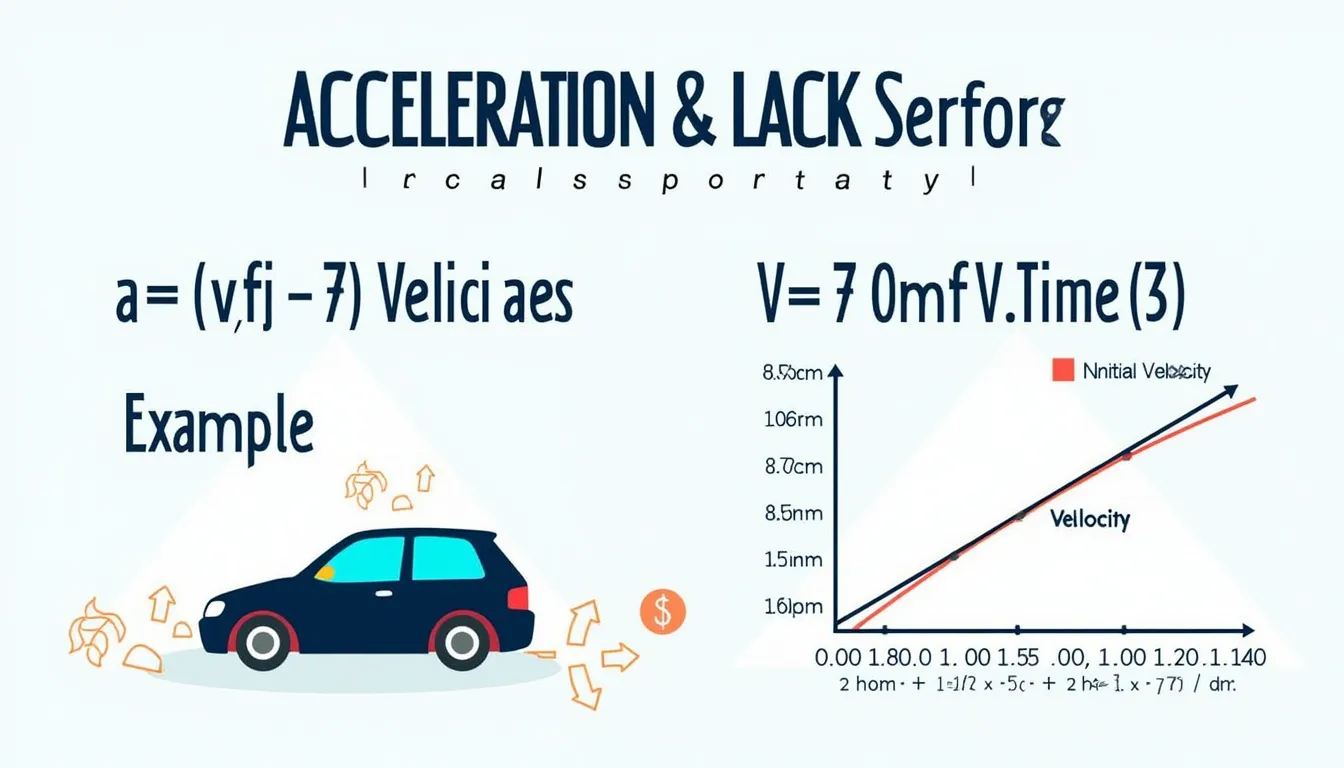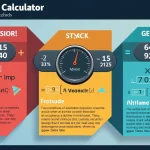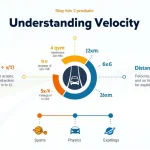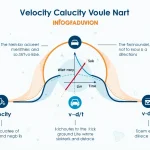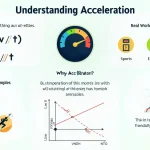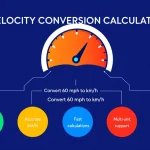Acceleration Calculator
Is this tool helpful?
How to Use the Acceleration Calculator Effectively
Our Acceleration Calculator is a powerful tool designed to help you calculate the rate of change in velocity over time. Whether you’re a student studying physics, an engineer working on motion-related projects, or simply curious about the world of mechanics, this calculator offers a quick and accurate way to determine acceleration. Here’s how to use it effectively:
- Enter Initial Velocity: Input the starting velocity of the object in meters per second (m/s) in the “Initial Velocity” field.
- Input Final Velocity: Enter the ending velocity of the object in meters per second (m/s) in the “Final Velocity” field.
- Specify Time Interval: Add the duration over which the change in velocity occurs, measured in seconds (s), in the “Time” field.
- Calculate: Click the “Calculate” button to obtain the acceleration result.
- View Result: The calculated acceleration will be displayed in meters per second squared (m/s²).
Remember, acceleration can be positive (indicating an increase in velocity) or negative (indicating a decrease in velocity). The calculator automatically handles both scenarios, providing you with the correct result.
Understanding Acceleration: Definition, Purpose, and Benefits
Acceleration is a fundamental concept in physics that describes how quickly an object’s velocity changes over time. It’s expressed mathematically as:
$$ a = \frac{\Delta v}{\Delta t} = \frac{v_f - v_i}{t} $$Where:
- ( a ) is acceleration
- ( Delta v ) is the change in velocity
- ( Delta t ) is the change in time
- ( v_f ) is the final velocity
- ( v_i ) is the initial velocity
- ( t ) is the time interval
Understanding acceleration is crucial for various applications, from analyzing the performance of vehicles to studying the motion of celestial bodies. Our Acceleration Calculator simplifies this process, allowing you to quickly determine acceleration without manual calculations.
Benefits of Using the Acceleration Calculator
Utilizing our Acceleration Calculator offers numerous advantages:
- Time-saving: Eliminate the need for manual calculations, allowing you to focus on interpreting results and applying concepts.
- Accuracy: Minimize human error and ensure precise results every time.
- Flexibility: Calculate acceleration for various scenarios by simply adjusting input values.
- Educational tool: Reinforce your understanding of acceleration and its relationship to velocity and time.
- Practical applications: Use in real-world situations, from physics homework to engineering projects.
- Instant feedback: Receive immediate results, facilitating quick comparisons and analyses.
- User-friendly interface: Intuitive design makes it accessible for users of all levels.
Addressing User Needs and Solving Specific Problems
Our Acceleration Calculator addresses several common challenges faced by students, educators, and professionals:
1. Simplifying Complex Calculations
Calculating acceleration manually can be time-consuming and prone to errors, especially when dealing with complex scenarios or large datasets. Our calculator streamlines this process, providing accurate results in seconds.
2. Enhancing Understanding of Physics Concepts
By allowing users to experiment with different values, the calculator helps reinforce the relationship between acceleration, velocity, and time. This hands-on approach can significantly improve comprehension of these fundamental physics concepts.
3. Supporting Academic and Professional Work
From students working on physics assignments to engineers designing motion-controlled systems, our calculator serves as a valuable tool for verifying calculations and exploring various scenarios quickly.
4. Facilitating Real-world Problem Solving
The calculator can be applied to real-world situations, such as analyzing vehicle performance, studying projectile motion, or investigating the behavior of objects in different gravitational fields.
Practical Applications and Use Cases
The Acceleration Calculator finds applications in numerous fields and scenarios:
1. Automotive Engineering
Automotive engineers can use the calculator to analyze vehicle performance, such as:
- Determining the acceleration of a car from 0 to 60 mph
- Calculating braking deceleration rates
- Optimizing engine performance for different driving conditions
2. Sports Science
Sports scientists and coaches can leverage the calculator to:
- Analyze an athlete’s sprint performance
- Study the acceleration of a ball in various sports
- Optimize training routines based on acceleration data
3. Aerospace Engineering
In the aerospace industry, the calculator can assist in:
- Calculating the acceleration of aircraft during takeoff and landing
- Analyzing rocket propulsion systems
- Studying the motion of satellites and spacecraft
4. Physics Education
Educators and students can utilize the calculator for:
- Solving textbook problems and homework assignments
- Verifying manual calculations
- Exploring the effects of changing variables on acceleration
5. Robotics and Automation
Engineers working on robotics projects can use the calculator to:
- Design motion control systems for robotic arms
- Optimize the movement of autonomous vehicles
- Analyze the performance of conveyor systems in manufacturing
Example Calculations
Let’s explore some practical examples to illustrate how the Acceleration Calculator can be used:
Example 1: Car Acceleration
A car accelerates from 0 m/s to 27.8 m/s (100 km/h) in 8 seconds. Calculate its acceleration.
Inputs:
- Initial Velocity: 0 m/s
- Final Velocity: 27.8 m/s
- Time: 8 s
Using the calculator, we get:
Acceleration = 3.48 m/s²
Example 2: Braking Deceleration
A motorcycle traveling at 20 m/s comes to a complete stop in 5 seconds. Calculate its deceleration.
Inputs:
- Initial Velocity: 20 m/s
- Final Velocity: 0 m/s
- Time: 5 s
Using the calculator, we get:
Acceleration = -4 m/s² (negative value indicates deceleration)
Example 3: Rocket Launch
A rocket accelerates from rest to 1000 m/s in 30 seconds during its initial launch phase. Calculate its acceleration.
Inputs:
- Initial Velocity: 0 m/s
- Final Velocity: 1000 m/s
- Time: 30 s
Using the calculator, we get:
Acceleration = 33.33 m/s²
Frequently Asked Questions (FAQ)
1. What is acceleration?
Acceleration is the rate of change of velocity with respect to time. It measures how quickly an object’s speed or direction changes.
2. What are the units of acceleration?
The standard SI unit for acceleration is meters per second squared (m/s²). Other common units include feet per second squared (ft/s²) and g-force (g).
3. Can acceleration be negative?
Yes, acceleration can be negative. A negative acceleration indicates that an object is slowing down or decelerating.
4. How is acceleration related to force?
According to Newton’s Second Law of Motion, force is equal to mass times acceleration (F = ma). This means that the acceleration of an object is directly proportional to the net force acting on it and inversely proportional to its mass.
5. What’s the difference between average acceleration and instantaneous acceleration?
Average acceleration is calculated over a period of time, while instantaneous acceleration refers to the acceleration at a specific moment. Our calculator provides the average acceleration over the given time interval.
6. Can this calculator be used for objects moving in two or three dimensions?
This calculator is designed for one-dimensional motion. For two or three-dimensional motion, you would need to consider acceleration components in each dimension separately.
7. How accurate is the Acceleration Calculator?
The calculator provides results rounded to two decimal places, which is sufficient for most practical applications. However, it’s important to note that the accuracy of the result depends on the precision of the input values.
8. Can I use this calculator for objects in free fall?
Yes, you can use this calculator to determine the acceleration of objects in free fall. On Earth, the acceleration due to gravity is approximately 9.8 m/s², but you can input your own values to account for different scenarios or planetary conditions.
9. Is there a limit to the values I can input?
While there’s no strict limit on input values, extremely large numbers may lead to rounding errors. For most practical scenarios, the calculator will provide accurate results.
10. Can this calculator handle complex motion scenarios?
This calculator is designed for uniform acceleration scenarios. For more complex motion involving varying acceleration, you would need to use calculus or more advanced tools.
Please note that while we strive for accuracy, we cannot guarantee that the webtool or results from our webtool are always correct, complete, or reliable. Our content and tools might have mistakes, biases, or inconsistencies.
Conclusion: Harness the Power of Acceleration Calculations
The Acceleration Calculator is an invaluable tool for anyone working with concepts of motion and velocity. By simplifying complex calculations, it enables users to focus on understanding and applying physics principles rather than getting bogged down in mathematical details.
Key benefits of using our Acceleration Calculator include:
- Time-saving efficiency
- Improved accuracy in calculations
- Enhanced understanding of physics concepts
- Versatility for various applications
- User-friendly interface for all skill levels
Whether you’re a student tackling physics homework, an engineer designing motion systems, or a curious individual exploring the principles of mechanics, our Acceleration Calculator empowers you to solve problems quickly and accurately.
We encourage you to experiment with different scenarios, explore the relationships between velocity, time, and acceleration, and apply this knowledge to real-world situations. By mastering the use of this tool, you’ll gain a deeper appreciation for the fundamental principles that govern motion in our universe.
Start using the Acceleration Calculator today and unlock new insights into the fascinating world of physics and motion!
Important Disclaimer
The calculations, results, and content provided by our tools are not guaranteed to be accurate, complete, or reliable. Users are responsible for verifying and interpreting the results. Our content and tools may contain errors, biases, or inconsistencies. We reserve the right to save inputs and outputs from our tools for the purposes of error debugging, bias identification, and performance improvement. External companies providing AI models used in our tools may also save and process data in accordance with their own policies. By using our tools, you consent to this data collection and processing. We reserve the right to limit the usage of our tools based on current usability factors. By using our tools, you acknowledge that you have read, understood, and agreed to this disclaimer. You accept the inherent risks and limitations associated with the use of our tools and services.
